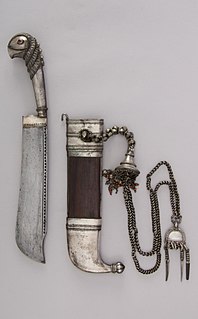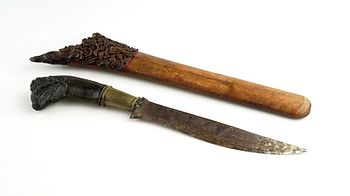
A Japanese sword is one of several types of traditionally made swords from Japan. Bronze swords were made as early as the Yayoi period, though most people generally refer to the curved blades made from the Heian period to the present day when speaking of "Japanese swords". There are many types of Japanese swords that differ by size, shape, field of application and method of manufacture. Some of the more commonly known types of Japanese swords are the katana, tachi, odachi, wakizashi, and tantō.
A tachi is a type of traditionally made Japanese sword (nihonto) worn by the samurai class of feudal Japan. Tachi and katana generally differ in length, degree of curvature, and how they were worn when sheathed, the latter depending on the location of the mei (銘), or signature, on the tang. The tachi style of swords preceded the development of the katana, which was not mentioned by name until near the end of the twelfth century. Tachi were the mainstream Japanese swords of the Kotō period between 900 and 1596. Even after the Muromachi period (1336–1573), when katana became the mainstream, tachi were often worn by high-ranking samurai.

A tantō is one of the traditionally made Japanese swords that were worn by the samurai class of feudal Japan. The tantō dates to the Heian period, when it was mainly used as a weapon but evolved in design over the years to become more ornate. Tantō were used in traditional martial arts (tantojutsu). The term has seen a resurgence in the West since the 1980s as a point style of modern tactical knives, designed for piercing or stabbing.
The yatagan, yataghan or ataghan, also called varsak, is a type of Ottoman knife or short sabre used from the mid-16th to late 19th centuries. The yatagan was extensively used in Ottoman Turkey and in areas under immediate Ottoman influence, such as the Balkans and the Caucasus.

The kris, or keris in the Indonesian language, is an asymmetrical dagger with distinctive blade-patterning achieved through alternating laminations of iron and nickelous iron (pamor). Of Javanese origin, the kris is famous for its distinctive wavy blade, although many have straight blades as well, and is one of the weapons commonly used in the pencak silat martial art native to Indonesia.

Japanese sword mountings are the various housings and associated fittings that hold the blade of a Japanese sword when it is being worn or stored. Koshirae (拵え) refers to the ornate mountings of a Japanese sword used when the sword blade is being worn by its owner, whereas the shirasaya is a plain undecorated wooden mounting composed of a saya and tsuka that the sword blade is stored in when not being used.

A kalis is a type of double-edged Filipino sword, often with a "wavy" section. The kalis has a double-edged blade, which is commonly straight from the tip but wavy near the handle. Kalis with fully straight or fully wavy blades also exist. It is similar to the Javanese keris, but differs in that the kalis is a sword, not a dagger. It is much larger than the keris and has a straight or slightly curved hilt, making it primarily a heavy slashing weapon.

A shotel is a curved sword originating in northern Ethiopia. The curve on the blade varies from the Persian shamshir, adopting an almost semicircular shape. The blade is flat and double-edged with a diamond cross-section. The blade is about 40 inches (1,000 mm) in total length and the hilt is a simple wooden or rhinoceros horn piece with no guard similar to the jile or jambiya. The shotel was carried in a close fitting leather scabbard which was often decorated in precious metals and worn on the right side.

Niabor is a curved sword from Borneo, a characteristic weapon of the Sea-Dayaks.
Parang Nabur is a sword that originates from Banjarmasin, South Kalimantan, Indonesia. Most of these swords were made during the Banjarmasin Sultanate period in the 19th century.

Balato is a sword that originates from Nias, an island off the west coast of North Sumatra, Indonesia.

The badik or badek is a knife or dagger developed by the Bugis and Makassar people of southern Sulawesi, Indonesia.

A Piso Halasan is a traditional sword of the Batak people from North Tapanuli Regency, North Sumatra, Indonesia.

Golok rembau is a type of golok in a shape of the tumbok lada, but in a larger version originating from Sumatra, Indonesia. It is also commonly found in Malaysia.

The bangkung or bangkon, is a short sword originating in the Sulu Archipelago of the Philippines. The bangkung was used primarily by the Moro people of the Sulu and is not associated with Moros in other areas such as Mindanao, although it is sometimes found in coastal regions. The bangkung is a slashing weapon, meant to deliver hacking type blows. While the bangkung is a very effective sword, it was not popular unlike the panabas and the pirah and for this reason it is one of the most rarely found Moro edged weapons. Few were produced and even fewer survive.

Pisau raut is a whittling knife that is commonly as a tool to prepare the rattan and other fine carving found throughout the entire Malay archipelago. It is well known as an accompanying knife placed in the same sheath with the mandau, a traditional weapon of the Dayak people.

Dao is the sword of the Naga people of Northeastern India, mainly in the Indian states of Assam and Nagaland. The sword, with its wooden hilt, and unique square form is used for digging as well as for killing.

Pichangatti is a broad-bladed knife of the Kodavas of Karnataka, India. The characteristic of the pichangatti is its silver hilt with bulbous-shaped pommel in the shape of a parrot's head. The pichangatti features in the traditional male dress of the Kodavas.
Odi katti is an indigenous weapon of war and tools to the Kodava people of Kodagu, in the state of Karnataka, India. The ayudha katti is developed from an implement used to cut through dense undergrowth. Unlike most blades, the odi katti is worn without a sheath.
The Pattern 1831 sabre for General Officers is a British army pattern sword prescribed for the use of officers of the rank of major-general and above. It has been in continuous use from 1831 to the present. It is an example of a type of sword described as a mameluke sabre.




















